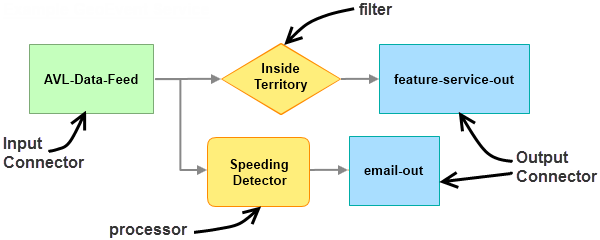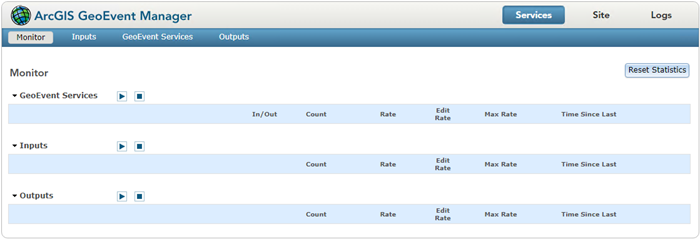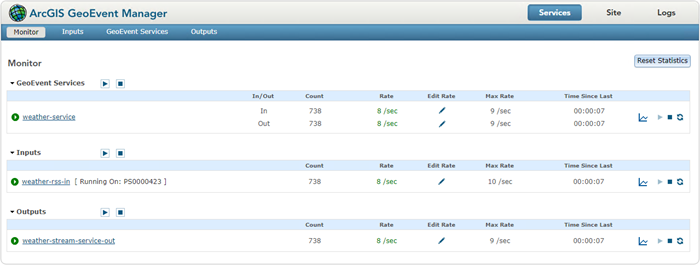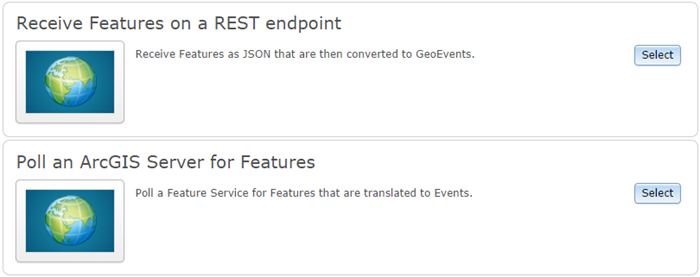ArcGIS GeoEvent Server is a server licensing role of ArcGIS Server that enables real-time ingestion and analytics on streaming data. The sections below highlight key functionality of GeoEvent Server. In addition, the GeoEvent Server Quick Start Guide (PDF) can be used as a quick reference for getting started with the Real-Time Visualization and Analysis capabilities of ArcGIS.
GeoEvent Services
A GeoEvent Service configures the flow of events, the filtering and processing steps to perform, what input connectors to apply them to, and what output connectors to send the results.

For details, see Overview of GeoEvent Services.
ArcGIS GeoEvent Manager
ArcGIS GeoEvent Manager is used to create and configure service components, as well as design, publish, and manage GeoEvent Services. Open GeoEvent Manager by browsing to https://gisserver.domain.com:6143/geoevent/manager. When opening GeoEvent Manager for the first time, an empty Monitor page, like the one shown below, is displayed.

Once input connectors, output connectors, and published GeoEvent Services are created, the Monitor page will contain those components as illustrated below.

For details, see Log in to GeoEvent Manager.
Creating connectors
GeoEvent Server includes connectors for creating both input connectors and output connectors. Connectors are available for common data formats (text, RSS, Esri feature JSON, and generic JSON) and data communication channels (system file, HTTP, TCP, UDP, WebSocket, and Esri feature service). An example of input connectors available with GeoEvent Server is illustrated below.

For details, see Managing connectors. For information on connectors, see Overview of input connectors and Overview of output connectors.
Creating GeoEvent Services
GeoEvent Services are created in GeoEvent Manager using a simple graphic interface similar to ModelBuilder. Use the service designer to add inputs and outputs to a GeoEvent Service. GeoEvent Services can also contain filters and processors that perform real-time analytics on the streaming data.
Once published, GeoEvent Services route event data from an input to any number of filters and processors, and out to one or more outputs. Input connectors are responsible for receiving and interpreting the event stream and translating the event data into a series of GeoEvents. Filters apply attribute and spatial filtering to identify GeoEvents of interest. Processors calculate derivative values, enrich GeoEvents by combining data from other services or files, tag GeoEvents based on spatial relationships, and work with GeoEvent schemas to map and reduce the fields from GeoEvents. Output connectors are responsible for converting the GeoEvents back to a data stream and sending the events through a selected data communication channel.
GeoEvent Server handles this processing and analysis of streaming event data all in real-time.
For details, see Overview of GeoEvent Services.
Bringing your applications to life
Streaming event data from GeoEvent Server can be utilized by the entire ArcGIS platform to bring everyday GIS applications to life. GeoEvent Server enables the integration of streaming data into an enterprise GIS by updating feature services and other online content. The features and content can then be consumed in web maps, apps such as ArcGIS Dashboards, or any ArcGIS viewer or application to display the most up-to-date information on events as they unfold.